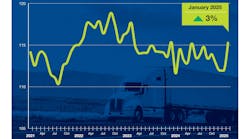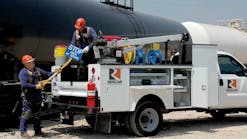Tank truck carriers and fleets fared better than their industry peers, and experienced less overall turbulence, in the last year, according to the Tank/Bulk edition of Cottingham & Butler’s 2023 Trucking Benchmark Compensation & Benefits report. Now Kim Beck, vice president of benefits consulting for the Iowa-based insurance broker, is renewing her request for more bulk haulers to participate in the annual survey.
The more data the firm collects, the more beneficial are the results.
“We had almost 70 tank and bulk haulers that participated,” Beck reported during National Tank Truck Carriers’ 2023 Annual Conference. “[But] that number hasn’t moved a lot in the last couple of years—so we need to do better.”
More than 300 motor carriers responded to the survey, which has benchmarked compensation and benefits in the overall trucking industry for more than 15 years, and annually provides a separate report on tank and bulk haulers in partnership with NTTC, primarily collecting responses from for-hire truckload carriers. In the tank and bulk segment, 62% of respondents were tank haulers, and 42% were bulk haulers, she said.
On a more granular level, most tank and bulk carriers hauled chemicals, with 90% of respondents stating they transport various chemical products. With companies able to report more than one industry they serve, 19% of survey participants reported moving food and beverages, 17% haul cement, and 14% sand, rock, and aggregate.
Of the responses garnered, the tank and bulk segment shared mostly good news in terms of stability, retainment, and compensation, especially compared to the trucking industry at large. This is partially due to the segment taking advantage of the benefits inherent to its services, Beck said, which assisted in tank/bulk’s retention and recruitment in five key areas: Pay, home time, equipment, location and freight, and benefits.
“Your segment, in terms of recruiting drivers, has a lot of advantages the rest of trucking doesn’t have,” Beck explained. “You get your drivers home more often. They drive less miles, so it’s not as hard for them in terms of miles driven. They’re making 10% more annually, on average, compared to driving in refrigerated and other types of segments in the industry outside of tank and bulk, and they’re happier.
“That shows from your lower turnover percentages.”
Frequent home time
In particular, Beck highlighted how the segment gets drivers home frequently, a massive benefit in an industry that demands long hours far from home. According to the report, 38% of tank/bulk haulers get drivers home every night and 35% said drivers were home three or more nights per week, meaning over 73% of tank/bulk drivers are home for much of their work week.
“That’s amazing,” Beck commented. “It was less than 15% in all trucking, outside of tank and bulk … [and] less than half of dry van and refrigerated haulers are doing that. These are talking points, something for your recruiters if you’re trying to pull people out of the other segments to drive for you.”
According to the survey, this is helped by the segment’s length of haul, which Beck said is different from the overall industry. With driver pay impacted by haul length, and length varying depending on freight, this aspect is as critical as it is elastic, Beck argued. Overall, 57% of tank/bulk haulers reported their average haul time as short haul, or less than 200 miles; 31% reported they drove intermediate haul, or 201-500 miles; and 7% long haul, which is 501 miles or higher.
“This chart looks very different in the all-trucking segment,” Beck noted. “88% [of tank/bulk haulers] reported their average length of haul [is] below 500 miles per trip. It’s more than half, or over 500 miles, in dry and refrigerated.”
Conversely, while bulk and tank drivers are taking shorter trips, their vehicles are on the road longer throughout their lives, with 62% of respondents stating their fleet vehicles are 3-4 years old, 14% are 1-2 years old, and 23% are five or more. “What we’re finding is that the average age of tractors has increased since we’ve been doing the survey over the last few years,” Beck noted. “And it’s not because you guys want to keep your trucks longer.
“It’s because of the supply issues with getting new trucks.”
Flexible compensation
Despite this, Beck said tank/bulk turnover “historically” has remained low in comparison to other segments. But in more recent years, the survey noted that 2022’s voluntary turnover was higher than this year’s, with the former coming in at 42% and the latter at 38%, she said. Specifically, 27% of 2023’s respondents stated they experienced 31-40% voluntary turnover, which still placed it well below the industry average.
“In all trucking, that number is well over 50%,” Beck commented. “And we have a lot of clients with over 100% turnover. It’s starting to slow down, because freight has slowed down and they’re not replacing drivers as quickly. Still, your turnover’s pretty darn good.”
This decrease in turnover has impacted driver recruitment methods, which include driver referrals, word of mouth, and social media. “More so today, carriers are saying ‘Whatever, however you want to be paid, we’ll figure it out,’” Beck explained.
While most carriers in the segment reported paying drivers through a combination of methods, 72% said they pay by the hour, 52% by percentage of revenue or load, and 50% per mile. “That’s new within the last few years,” Beck observed. “Not everybody paid drivers per hour when we started doing this survey.”
Compensation increases leveled off across the segment while remaining 10% higher than in all other trucking segments in 2023, according to the survey. From 2022 to 2023, per mile compensation increased by 2%, percentage of revenue or load by 2%, per hour by 2%, and salaried or per day by 6% (likely due to new companies participating, Beck said).
An especially helpful data set was a comparison of methods used to pay drivers by haul, which outlined the average pay a driver could earn in each haul on a per-mile, percentage of revenue/load, per-hour, and per-day basis. This revealed big differences in pay, such as in chemical haul, which could offer drivers $89,000 per year if measured by the percentage of revenue or load, instead of $84,000 per mile or $75,700 when paid by the hour.
“If you want to talk about how you’re paying a percentage, and your peers or competitors are paid by the mile, and why one is better than the other, there you go,” Beck asserted. “Per hour, they’re only going to make $75,000.”
Added benefits
But how did bonuses and benefits impact tank/bulk driver compensation?
Clean DOT inspection produced the most common bonuses in 2023, with 65% of respondents reporting they pay these out at an average of $100. Meanwhile, the number of organizations offering sign-on bonuses, which averaged $3,100, remained level from 2022 to 2023, a massive difference from when they jumped 70% last year. Tenure bonuses also remained at 2% and dropped in amount from $1,200 to $950, likely “because you guys are paying more per mile or percentage for staying with the company longer,” Beck explained.
Finally, 90% of responding tank/bulk haulers offer medical plans; paid vacation, holidays, sick leave, and/or PTO; group-employer-paid life insurance; and 401k and/or profit-sharing plans, the survey found. In addition, more companies are offering voluntary benefits in a continuing trend, with the most common including voluntary life insurance (79%), accident insurance (67%), and voluntary short-term disability (59%).
While increased offerings and varying plan options are positive, Beck said the segment still can do more to support driver wellness.
“These guys are not getting younger,” Beck said. “Their health risks are going to continue to get worse, and the driver shortage is already bad enough without losing drivers to health reasons. So we’ve all got do something together to try to encourage people to make better lifestyle choices while they’re on the road.”
The full report is available to participants, and the tank/bulk-specific report is available to NTTC members. Carriers who didn’t participate in 2023 can contact Beck at [email protected] or click here for more information about the survey.














